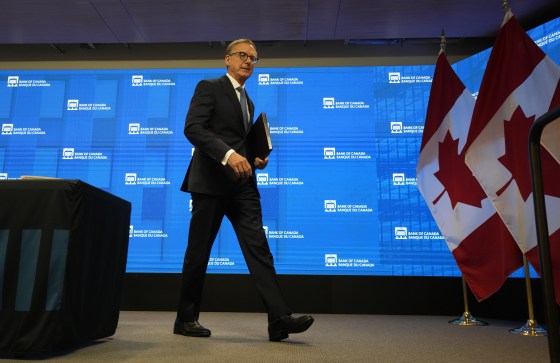|
If ever there was an indication countries shouldn’t want their central bank’s policy decisions driven by politics, it’s the thin tightrope Bank of Canada governor Tiff Macklem is currently navigating.
While inflation, according to the bank’s wide-ranging analysis, remains stubborn at 2.5 per cent, it cut its overnight lending rate last week to 2.5 per cent.
It’s unusual for a central bank to cut rates while inflation remains strong, but in this case, the bank is forecasting a slowdown due to weakening job numbers and the ongoing trade uncertainty with the United States.
Advertisement
 Why this ad? Why this ad?

Bank of Canada governor Tiff Macklem announces a quarter-point cut, to 2.5 per cent, in the overnight lending rate Wednesday. (Adrian Wyld / The Canadian Press)
Lower interest rates encourage spending, primarily by making loans more attractive, but unchecked, spending can spiral into inflation, which diminishes the value of savings and, of course, makes everything more expensive.
It does that in a couple of ways: in order to maintain profitability, companies raise prices, which, owing to the availability of money, consumers are willing to pay.
Think of it also as hitting your savings: if you have a GIC paying two per cent and inflation is 2.5 per cent, you’re essentially losing a half per cent.
(As an aside, this, in a nutshell, is why your investment portfolio should include at least some growth assets, such as stocks, which are most wisely held by small investors in mutual funds. The growth over time is very likely to exceed inflation, keeping you ahead of the wave.)
All of this is a way to say central banks have to stay ahead of coming developments. The levers of the economy can be sensitive, and waiting for a slowdown to cut rates or for inflation to raise rates can make the resulting moves more drastic.
Those of us who remember the high interest rates of the early 1980s certainly don’t want to see a repeat.
Inflation, once it spirals out of control, can be devastating.
Consider Argentina: the exchange rate for the peso can vary by the day, if not the hour.
Try exchanging in Canada. You can’t. That has created a black market currency exchange in the country where you get favourable rates but the transaction feels more like a drug deal than a money swap. I know: I’ve been there.
Consider post-First World War Germany, where hyperinflation destroyed the economy and deprived the German mark of all its value. That fed into the perfect storm of economic discontent and global isolation that allowed fascism to take over.
This is all exactly why our friends south of the border should be very leery of political pressure on the U.S. Federal Reserve to cut rates.
Politics and objective analysis are not bedfellows. The lure of cutting rates to score political points is just too strong. Coincidentally, the Fed did cut rates last week, citing much the same analysis as is behind the Bank of Canada’s decision.
|

